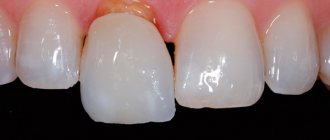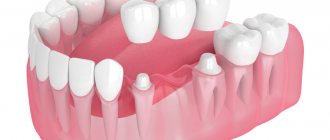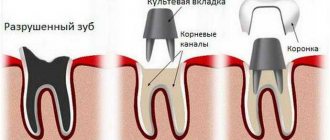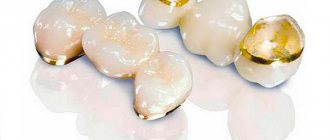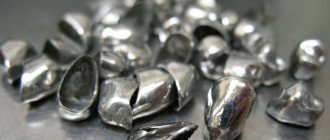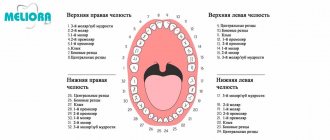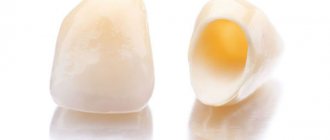10345
A crown is a single permanent prosthesis that acts as a kind of cap on a damaged tooth, and can serve its owner for 15 years, subject to the installation regulations and rules of care during use.
However, if an unpleasant odor or painful sensations appear, it becomes necessary to dismantle the structure.
Removing a crown from a tooth is an unpleasant procedure, but in some cases it is the only way to eliminate the problem.
Indications
Prosthetics with crowns is a labor-intensive and time-consuming procedure, sometimes accompanied by pain and discomfort.
To remove the structure, the specialist must have compelling reasons, otherwise he will do everything possible to avoid extreme measures.
A fixed orthopedic device is subject to disposal in the following cases:
- Incorrect installation of the product .
The crown may lose stability due to mistakes made by the doctor during its installation, the use of low-quality dental cement, or the destruction of the filling connecting material at the junction points. It is easy to recognize such a problem, since the dental unit begins to loosen and cause discomfort during eating and conversation. - Formation of a cyst on a tooth under a denture . This pathology rarely occurs as a result of various provocateurs. After removing the structure, the specialist removes the abnormal cavity and carries out full treatment.
- Destruction of an adjacent tooth . Another indication for re-prosthetics. In such a situation, the doctor advises installing a bridge instead of two adjacent prostheses.
- Bad odor and toothache. In this case, there is an urgent need for treatment hidden under the structure of the teeth.
Signs of the inflammatory process can develop against the background of the action of infectious agents, progression of pulpitis or secondary caries. In less severe situations, the doctor does not remove the prosthesis, but drills a small hole in it through which he carries out therapeutic treatment.After all the necessary manipulations have been carried out, the hole is filled with cement. Such work significantly reduces the service life of the structure.
- Inflammatory processes in the periodental tissues and gum disease .
Disease processes in periodontal tissues can develop due to various factors - inflammation, trauma, poor-quality manufacturing and fixation of the product. The structure puts strong pressure on the free gum, rubs, and a serious pathology begins to develop that cannot be treated independently. The product must be removed with subsequent treatment of soft structures. - Repeated prosthetics at the request of the patient . The patient can independently decide to replace the device with a more expensive and high-quality product.
- Broken prosthesis . The appearance of cracks and chips on the surface of the crown is also a reason for its dismantling.
Features of the production of Noritake metal-ceramic crowns, their advantages and disadvantages.
Come here if you are interested in the characteristics of Duceram metal-ceramic crowns.
At this address https://www.vash-dentist.ru/protezirovanie/nesemnyie-p/koronki-np/metallokeramicheskih-vita.html there is a detailed description of the Vita crown.
Treatment without removing the structure
In practice, it is rarely possible to reuse a structure after its removal and tooth treatment. Most often, you have to re-create the prosthesis, which means additional expenses and days of waiting. But in some situations you can do without removing the crown at all. For example, a doctor can perform root canal treatment by first forming a small hole directly in the prosthesis or, for example, through an incision in the gum if a cyst needs to be removed. If manipulations are performed through a slot in artificial material, upon completion of the procedure, the doctor will carefully close the defect with filling material.
In some cases, treatment can be carried out without removing the crowns
You need to understand that such treatment can only be done by an experienced, highly qualified professional. It is also important that the pathological process is at an early stage of its development. While the problem has not yet reached a large scale, there remains a chance to eliminate it with minimal losses. And in order to be able to detect this problem in time, it is necessary to regularly visit the dentist’s office once every six months - for prevention and professional cleaning of plaque and deposits.
1Borovsky E.V. Therapeutic dentistry, 2003.
Techniques
In dental practice, various methods of removing crowns are used. The choice depends on the existing clinical picture and the target direction of dismantling.
The decision on the method used is made by the patient, taking into account his financial capabilities and the time he can devote to it. Let's consider the existing options in detail.
Kopp apparatus
A crown remover is a dental instrument that greatly simplifies the work of a specialist and gives him the opportunity to painlessly remove the prosthesis without resorting to its destruction.
The device looks like a special hook , the operation of which is started by a button located on the holder. The procedure begins with breaking the cement under the structure using a drill. Next, using special forceps and hooks, the crown is picked up and picked out.
The method is considered a low-traumatic and painless procedure. However, it has one significant drawback - in some cases the device leaves scratches on the ceramic coating of the product , as a result it will require restoration.
Coronaflex device
The device operates on the basis of compressed air , which destroys cement. At the beginning of the procedure, the device should be operated with minimal impact force to avoid damage to the tooth.
The crown in the chewing area is removed using forceps. The device is installed so that its body is under the arc of the forceps.
special brackets as auxiliary tools , which are fixed on the crown using an adhesive system. Then the procedure continues according to the principle of the previous method with forceps.
When using the Coronaflex device, there is practically no risk of damage to a fixed prosthesis , but the price of the instrumentation is quite high, which affects the cost of removing the structure.
For this reason, the use of the device is justified in a situation when it becomes necessary to dismantle an expensive crown, for example, made of zirconium dioxide.
What are porcelain dental crowns and how practical are they?
In this publication you will find detailed information about steel crowns.
Here https://www.vash-dentist.ru/protezirovanie/nesemnyie-p/koronki-np/bolit-zub-pod-chto-delat.html we will answer the question: why does the tooth under the crown hurt when pressed.
Sawing
After using this method, repeated prosthetics with the same design is impossible.
Many patients mistakenly believe the procedure is painful, but in fact their fear is in no way justified. During sawing, the patient does not even experience any discomfort.
As a rule, this method is used in the case of inexpensive products that are subject to liquidation. Usually we are talking about metal ceramics.
However, specialists often resort to cutting to remove ceramic crowns, which requires the use of a diamond bur and special tools .
Ultrasound
Under the influence of a sound wave, cement loses its stability. But this method is not applicable to every material.
If we are talking about glass ionomer cement (a material based on polyacrylic acid and aluminofluorosilicate glass powder), its use is devoid of expediency and practical benefit.
Thanks to this method, the doctor can preserve the model and its shape without damage.
The video shows the process of removing the crown.
How to remove crown dentures in dentistry
As for which doctor removes crowns from teeth, it needs to be clarified that such a procedure falls within the competence of both orthopedists and endodontists. At the same time, today specialists have at their disposal different methods for extracting such structures - let’s look at them in more detail.
Cutting the prosthesis using a bur
The classic option for dismantling a single prosthesis. The artificial material is literally sawn apart and then carefully removed, but the product is no longer suitable for re-prosthetics. This is a simple and accessible method, which, however, requires sufficient experience and skill from the doctor, since all actions must be performed as carefully as possible so as not to injure the living tissues of the tooth and the adjacent mucous membrane.
This is how a prosthesis is cut using a bur
This option is suitable if you need to remove a budget crown model, which you would then not mind sending for scrap. This method is also recommended in cases where the product is already damaged or wobbly. The doctor cuts the structure until it meets the dental tissues, after which, using hand tools, he bends its edges in opposite directions and takes out the denture in parts.
Removal using ultrasound
One of the fastest, safest and most modern methods of removing an artificial crown involves the use of ultrasound. By directly affecting the cement composition, ultrasonic waves lead to the destruction of the binder material. This approach allows you to remove the product without the slightest damage, but the technique also has its drawbacks. Thus, ultrasonic vibrations reproduce a gentle, but too soft effect, which may not always lead to the desired result the first time. In some situations, the patient has to visit a specialist several times.
Ultrasound can also be used to remove the product.
Another point is that this hardware method allows you to remove products made from materials that are not too dense. For example, glass ionomer structures cannot be removed using ultrasound1. In addition, many patients note that ultrasonic vibrations in the oral cavity do not cause the most pleasant sensations, which may be associated with some discomfort during the procedure.
Manual crown remover
Here we are talking about a special tool with metal hooks attached to the end. It is with these hooks that the doctor carefully picks up the edges of the prosthetic structure and pulls it. The shock wave, combined with the force applied by the doctor, leads to the destruction of the cement base, thanks to which the specialist is able to carefully remove the product from the oral cavity.
The photo shows a manual crown remover
Application of the KOPPA (Koch) apparatus
The device in the form of a tool is somewhat similar to a crown remover. There is also a small hook at the end, but this device is activated using a button. It provides a mechanical effect leading to the destruction of cement along the edge of the prosthetic device. As soon as the structure becomes mobile, the doctor takes special forceps and uses them to remove the prosthesis from the oral cavity.
The photo shows the COPP (Koch) apparatus
The use of the KOPP apparatus makes the procedure simpler and less traumatic. However, this method also has its drawbacks. For example, during dismantling, the patient may experience some discomfort due to the twitching of the instrument, which is clearly felt in the mouth. In addition, the device makes a not very pleasant sound. Another disadvantage is that the device can damage the integrity of the ceramic coating, leaving cracks and chips on it, in which case the product will have to be repaired.
"Coronaflex" - a modern approach
This device resembles a pistol in appearance. The air in it is in a compressed state and, after activation, comes out under high pressure, as a result of which the structure of the cement base on which the crown rests is destroyed. At the same time, the prosthesis itself remains intact and intact, as does the surrounding mucosa.
“Immediately after installing the crown, the doctor warned me: if you don’t want problems in the near future, brush it constantly like your teeth and it’s better to buy an irrigator. By the way, it’s a cool thing, very convenient, I recommend it to everyone. But my brother just recently had it removed with coronaflex. According to him, the procedure was not the most pleasant, although it was performed with anesthesia. There was no pain, but it didn’t feel very comfortable.”
Leha1991, from correspondence on the forum www.32top
A more modern device is Coronaflex
. Not every dental clinic has such a device. The procedure using it will cost an order of magnitude more than dismantling using the methods described above. This approach is recommended for the extraction of expensive products, for example, zirconium. Subsequently, such a single prosthesis can be used again to hide the dentition defect. Patients note that the procedure takes place in more comfortable conditions, and doctors praise the device for its ease of use and speed of extraction.
About pain and self-liquidation
The level of complexity and pain of each of the listed methods depends on the experience and professionalism of the doctor.
If the removal of the structure involves the destruction of the cement base, the crown easily falls out, such manipulation is easy and painless.
If a fixed prosthesis is installed firmly and stably, and dismantling requires maintaining the integrity of the product, the duration of the procedure increases, which causes discomfort in the patient. In such cases, the use of anesthesia is appropriate .
If there is severe pain under the structure, a person looks for forced ways to eliminate the product at home. Lack of experience and special equipment are considered to be the cause of adverse consequences.
Any attempts to independently remove the prosthesis lead to its damage or injury to the soft tissues of the oral cavity.
For this reason, such manipulations are carried out in a clinical setting. A qualified doctor with special equipment will perform correct crown removal.
You can remove the orthopedic device yourself in two cases:
- the product has become loose or has come off together with the cement base;
- the structure fell apart and it became necessary to extract the remaining fragments.
To avoid further complications, a person should seek help from a specialist as soon as possible.
Is it possible to remove the crown yourself?
The crown is a non-removable orthopedic system, which means that it is absolutely impossible to try to remove it on your own at home, even if it is loose. Only a good specialist can carry out the procedure efficiently, and only with the appropriate experience. Otherwise, unjustified arrogance risks leading to irreversible consequences.
You may accidentally damage the product and render it unusable or seriously injure the surrounding soft tissues, and even the tooth itself. In the worst case scenario, it will have to be completely removed, and then the inflammatory process resulting from infection in the injured tissues will have to be treated.
Price
The complexity of the process and its cost will largely depend on the material of the permanent structure and the type of device with which it will be removed.
Let's look at the average cost of techniques using the table as an example.
| Technique | Price in rubles for one prosthesis |
| Kopp apparatus | 1 000 |
| Coronaflex device | 1 500—1 800 |
| Sawing | 800 |
| Ultrasound | 900 |
Most dental clinics include in the cost of dismantling fixed structures the price for further treatment and re-prosthetics.
How does the withdrawal take place?
The procedure for removing a dental crown can be done in different ways. The most common of them is using the Koch apparatus. This device is placed in the patient's mouth, and by applying pressure to the edge of the crown, the crown is “displaced” without pain or damage. This method is often used when the patient wants to keep the dental crown intact. If the integrity of the crown is not so important, you can remove the crown by simply sawing it. This method often frightens patients, since the preparation process is quite complicated. During filing, ultrasound is applied to the tooth, causing the material to crack, allowing the tooth to be freed. Sawing severely damages the structure, so installing the same crown will not be possible.
You can carefully remove the crown using the Coronaflex device. The orthopedic design completely retains its shape, so it can be reinstalled.
Following actions
After removal of the orthopedic product, the patient may experience discomfort and pain.
To identify the cause of pain, a specialist examines the condition of the tooth. In some cases, radiography is performed for an accurate diagnosis.
The doctor’s algorithm for further actions will depend on the situation as a result of which the crown had to be removed:
- Treatment of the inflammatory process. In the presence of diseases such as pulpitis, caries and periodontitis, the root canals of the tooth are unfilled.
Next, the doctor’s task is to prevent the pathological process in tissues using anti-inflammatory therapy. At the last stage of treatment, a filling is installed. - Restoration. To prevent subsequent destruction of the crown if it is damaged or chipped, restoration measures are required.
- Replacement of cement when it is destroyed . Here it is important to quickly treat the stump with antiseptic agents and re-fix the prosthesis using new dental cement.
- Replacement of the structure at the request of the patient or if it is impossible to reuse it .
Using an x-ray, the doctor evaluates the quality of filling the dental canals, as well as the condition of the periodontal structures. After this, you can select and order a new design.
The therapeutic course of treatment includes the following procedures:
- to fight infection and eliminate inflammation, the patient is prescribed medications from the group of antibiotics;
- Rinsing the mouth with decoctions of medicinal herbs and Furacilin solution is effective;
- To reduce pain, dentists recommend using anti-inflammatory compresses with an analgesic effect.
A paste made from 1 tablet of Nurofen and a few drops of boiled water has worked well here. It is rubbed into the wound area.
In rare cases, the tissue under the crown becomes permanently damaged and cannot be saved. Under such circumstances, the doctor warns the patient about the extraction of the tooth from the alveolus and the impossibility of re-fixing the crown.
As an alternative, you can choose another prosthetic option or resort to implantation.
Is it possible to cure a tooth without removing the crown?
The integrity of the prosthesis can be preserved in the following cases:
- When the tooth was depulped during installation. First, the doctor will numb the tooth, then drill a small hole in the crown from the chewing surface. It will clean the walls of the canals, seal them and close the hole. This procedure will be carried out in several stages.
- When the tooth was not pulpless when the crown was installed. In this case, the dentist will administer anesthesia and then drill a thin hole in the crown. He will remove the dental nerve, clean the canal and treat the area with an antiseptic. He will fill the canals and place a seal on the drilled hole.
- If the gums around the crown are swollen, then an experienced doctor will clean the oral cavity without removing the denture.
These three cases are somewhat generalized. In each case, the dentist makes a decision on an individual basis. If the tooth under the crown is severely damaged, then even the most experienced professional will not do without first removing the crown in order to provide qualified assistance.
However, the sooner you contact a specialist, the more likely it is that the tooth will be treated without first removing the denture. If the crown was recently placed, it is well made and of high quality, then it makes sense to try to preserve the prosthesis.
In this case, the material of the crown does not matter. You can save metal-ceramics, metal, and zirconium oxide.
Remember that only timely medical care guarantees the preservation of the tooth.
Reviews
Dental prosthetics is not the cheapest service provided by dental clinics. Therefore, before the procedure, it would be useful to approach the search for an experienced doctor with special care.
This will help avoid unforeseen situations when, due to mistakes made during installation, re-prosthetics cannot be avoided.
If after reading the article you would like to share your own opinion on this topic, leave your comment below.
If you find an error, please select a piece of text and press Ctrl+Enter.
Tags: dental crowns, fixed dentures, removal of a crown from a tooth
Did you like the article? stay tuned
Previous article
The essence of using individual zirconium abutments
Next article
The use of an angular abutment to achieve high aesthetic prosthetics
